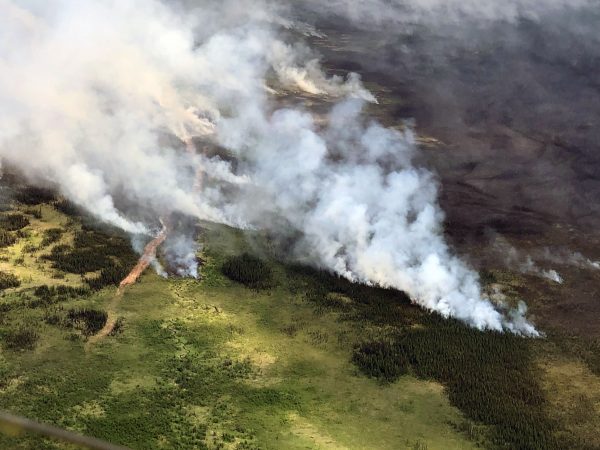
A wildfire near Sterling on the Kenai Peninsula grew to about 8,400 acres as of Friday, according to the Division of Forestry.
About 70 firefighters, along with helicopters dumping water, are now assigned to the lightning-caused Swan Lake Fire, burning in the Kenai National Wildlife Refuge. The fire had not currently threatening any structures as of Friday.
Still, Sarah Saarloos with the Division of Forestry said recent fire growth prompted officials to switch from monitoring the fire to actively managing it.
Saarloos says the fire was about three miles north of the Sterling Highway on Friday.
“And it’s been hung up there for the last couple days, because we haven’t had any strong winds pushing it towards the highway, and it’s also in a really marshy area with not a lot of continuous fuels,” Saarloos said. “And then over in the area closest to the community of Sterling, that is where we’ve inserted our three crews.”
Saarloos said the University of Alaska Fairbanks fire crew has joined the Pioneer Peak and Gannett Glacier fire crews to protect the nearby town, gas pipeline and highway.
Most of the fire’s significant recent growth was not toward any infrastructure, Saarloos said.
“This morning when people woke up, they did smell more of a smoke smell than in the previous days, because of that fire growth that we had,” Saarloos said. “But most of it was up on the northeast corner, burning into the refuge, so not down to the highway or the community of Sterling.”
Smoke is affecting visibility at times, so motorists should use caution, especially between miles 65 and 75 of the Sterling Highway, Saarloos said. Some local roads were affected, and pilots should be aware of a temporary flight restriction in the area.
Managing the fire has been a collaborative effort with federal wildlife refuge officials, Saarloos said. She said that includes even before the fire, when federal and state personnel cut fire breaks to help prevent the uncontrolled spread of wildfires in the area.
According to the Division of Forestry, part of the mangement plan is to allow the Swan Lake Fire to burn in some areas, creating a natural fire break.
According to a written statement from the Division of Forestry, that will “reduce future wildland fire hazards and enhance wildlife habitat by allowing for fire’s natural role: creating a diversity of vegetation types and tree age classes.”
More information is available at akfireinfo.com.
Casey Grove is host of Alaska News Nightly, a general assignment reporter and an editor at Alaska Public Media. Reach him at cgrove@alaskapublic.org. Read more about Casey here.





